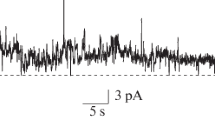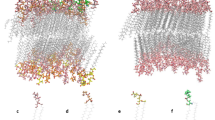Summary
The equilibrium-binding affinities of six adriamycin analogues and four daunomycin derivatives for negatively charged dimyristoyl phosphatidylcholine/dimyristoyl phosphatidic acid (DMPC/DMPA) small unilamellar vesicles are compared with values for electroneutral DMPC liposomes. Binding of the daunomycin series to negatively charged dimyristoyl phosphatidyl glycerol (DMPG) vesicles was also examined. Under physiological conditions of pH and ionic strength, substitution of the amino group of adriamycin or daunomycin resulted in a reduced affinity for negatively charged bilayers, even if the substituent enhanced the degree of ionization of the amine. Decreasing the ionic strength increases the binding affinity for acidic membranes but decreases the drug affinity for neutral membranes. We propose that the electrostatic bond of the phosphate-amino group that has been shown to exist between anthracyclines and phosphatidic acid is sterically destabilized by substitution of the amino group. The results are consistent with a mode of anthracycline binding to negatively charged membranes which is driven by hydrophobic and electrostatic considerations but is destabilized by steric bulk at the amino group. THe data also provide insight into the design of new anthracyclines with high membrane affinities and reduced uptake; such directed interaction with plasma membranes may enhance antineoplastic potential while reducing cardiac toxicity.
Similar content being viewed by others
Abbreviations
- DMPC:
-
l-α-dimyristoyl phosphatidylcholine
- DMPG:
-
L-α-dimyristoyl phosphatidyl glycerol
- DMPA:
-
l-α-dimyristoyl phosphatidic acid
- TLC:
-
thin-layer chromatography
- PBS:
-
phosphate-buffered saline containing 8 mM Na2HPO4, 1 mM KH2PO4 and the specified amount of KCl(pH 7.4)
- Tm :
-
gel to liquid-crystalline phase transition temperature
- DMPG:
-
l-α-dimyristoyl phosphatidyl glycerol
- SUVs:
-
small unilamellar vesicles
References
Acton EM (1980) N-Alkylation of anthracyclines. In: Crooke ST, Reich SD (eds) Antracyclines: Current status and new developments. Academic Press, New York
Acton EM, Tong GL, Mosher CW, Wolgemuth RL (1984) Intensely potent morpholinyl anthracyclines. J Med Chem 27:638–645
Bachur NR, Gordon SL, Gee MV (1977) Anthracycline antibiotic augmentation of microsomal electron transport and free radical formation. Mol Pharmacol 13: 901–910
Barthelemy-Clavey V, Maurizot JC, Dimicoli JL, Sicard P (1974) Self-association of daunorubicin. FEBS Lett 46: 5–10
Burke TG, Tritton TR (1984) Ligand self-association at the surface of liposomes: a complication during equilibriumbinding studies. Anat Biochem 143: 135–140
Burke TG, Tritton TR (1985 a) Structural basis of anthracycline selectivity for unilamellar phosphatidylcholine vesicles: an equilibrium-binding study. Biochemistry 24: 1768–1776
Burke TG, Tritton TR (1985 b) Location and dynamics of anthracyclines bound to unilamellar phosphatidyl vesicles. Biochemistry 24: 5972–5980
Burke TG, Morin MJ, Sartorelli AC, Lane PE, Tritton TR (1987) Function of the anthracycline amine in membrane binding: Cellular transport and cytotoxicity. Mol Pharmacol 31: 552–556
Calendi E, DiMarco A, Reggiani M, Scarpinato B, Valentini L (1965) On physico-chemical interactions between daunomycin and nucleic acid. Biochim Biophys Acta 103: 25–49
Chaires JB, Dattagupta N, Crothers DM (1982) Self-association of daunomycin. Biochemistry 21:3927–3932
Chang EL, Gaber BP, Sheridan JP (1982) Photon correlation spectroscopy study on the stability of small unilamellar DPPC vesicles. Biophys J 39: 197–201
Dalmark M, Storm HH (1981) A Fickian diffusion transport process with features of transport catalysis. Doxorubicin transport in human red blood cells. J Gen Physiol 78: 349–364
Duarte-Karim M, Ruyscchaert JM, Hildebrand J (1976) Affinity of adriamycin to phospholipids: a possible explanation of cardiac mitochondrial lesions. Biochem Biophys Res Commun 71: 658–663
Gaber BP, Sheridan JP (1982) Kinetic and thermodynamic studies of the fusion of small unilamellar phospholipid vesicles. Biochim Biophys Acta 685: 87–93
Goldman R, Facchinetti T, Bach D, Raz A, Shinitzki M (1978) A differential interaction of daunomycin, adriamycin and their derivatives with human erythrocytes and phospholipid bilayers. Biochim Biophys Acta 512: 254–269
Goodman J, Hochstein P (1977) Generation of free radicals and lipid peroxidation by redox cycling of adriamycin and daunomycin. Biochem Biophys Res Commun 77: 797–803
Goormaghtigh E, Chatelain P, Caspers J, Ruysschaert JM (1980) Evidence of a specific complex between adriamycin and negatively charged phospholipids. Biochim Biophys Acta 597: 1–14
Graham I, Gagne J, Silvius JR (1985) Kinetics and thermodynamics of calcium-induced lateral phase separations in phosphatidic acid containing bilayers. Biochemistry 24: 7123–7131
Henry N, Fantine EO, Bolard J, Garnier-Suillerot A (1985) Interaction of adriamycin with negatively charged model membranes evidence of two types of binding sites. Biochemistry 24: 7085–7092
Kraczmar GS, Tritton TR (1979) The interaction of adriamycin with small unilamellar vesicle liposomes. A fluorescence study. Biochim Biophys Acta 557: 306–319
Kovaouci R, Silvius JR, Graham I, Pezolet M (1985) Calcium-induced lateral phase separations in phosphatidylcholine-phosphatidic acid mixtures. A Ramon spectroscopic study. Biochemistry 24: 7132–7140
Lenaz L, Page JA (1976) Cardiotoxicity of adrimycin and related anthracyclines. Cancer Treat Rev 3: 111–120
Martin SR (1980) Absorption and circular dichroic spectral studies on the self-association of daunorubicin. Biopolymers 19: 713–721
Menozzi M, Valentini L, Vannini E, Arcamone F (1984) Selfassociation of doxorubicin and related compounds in aqueous solutions. J Pharm Sci 73: 766–770
Mosher CW, Wu HY, Fujiwara AN, Acton EM (1982) Enhanced antitumor properties of 3′-(4-morpholinyl) and 3′-(4-methoxy-1-piperidinyl) derivatives of 3′-deaminodaunorubicin. J Med Chem 25: 18–24
Papahadjopoulos D, Hui S, Vail WJ, Poste G (1976a) Studies on membrane fusion: I. Interactions of pure phospholipid membranes and the effects of myristic acid, lysolecithin, proteins and dimethyl sulfoxide. Biochim Biophys Acta 448: 245–264
Papahadiopoulos D, Vail WJ, Pangborn WA, Poste G (1976 b) Studies on membrane fusion: II. Introduction of fusion in pure phospholipid membranes by calcium ions and other divalent metals. Biochim Biophys Acta 448: 265–283
Poste GE, Papahadjopoulas D, Vail WJ (1976) Lipid vesicles as carriers for introducing biologically active materials into cells. Methods Cell Biol 14: 33–71
Rogers KE, Tokes ZA (1984) Novet mode of cytotoxicity obtained by coupling inactive anthracycline to a polymer. Biochem Pharmacol 33: 605–608
Rogers KE, Carr BI, Tokes ZA (1983) Cell surface-mediated cytotoxicity of polymer-bound adriamycin against drug resistant hepatocytes. Cancer Res 43: 2741–2748
Siegfreid JM, Burke TG, Tritton TR (1985) Cellular transport of anthracyclines by passive diffusion. Implications for drug resistance. Biochem Pharmacol 34: 593–598
Sturgeon RJ, Schulman SG (1977) Electronic absorption spectra and protolytic equilibria of doxorubicin direct spectrophotometric determination of microconstants. J Pharm Sci 66: 958–961
Suurkuusk J, Lentz BR, Barenholz Y, Biltonen RL, Thompson TE (1976) A calorimetric and fluorescent probe study of gel-liquid crystalline phase transition in small, single-lamellar dipalmitoylphosphatidylcholine vesicles. Biochemistry 15: 1393–1401
Thayer WS (1977) Adriamycin stimulated superoxide formation in submitochondrial particles. Chem Biol Interact 19: 265–278
Tokes ZA, Rogers KE, Rembaum A (1982) Synthesis of adriamycin-coupled polyglutaraldehyde microspheres and evaluation of their cytostatic activity. Proc Natl Acad Sci USA 79: 2026–2030
Tong GL, Wu HY, Smith TH, Henry DW (1979) Adriamycin analogues: 3. Synthesis of N-alkylated anthracyclines with enhanced efficacy and reduced cardiotoxicity. J Med Chem 22: 912–918
Tritton TR, Yee G (1982) The anticancer agent adriamycin can be actively cytotoxic without entering cells. Science 217: 248–250
Tritton T, Murphree S, Sartorelli A (1978) Adriamycin: a proposal on the specificity of drug action. Biochem Biophys Res Commun 84: 802–808
Wingard LB Jr, Tritton TR, Egler KA (1985) Cell surface effects of adriamycin and corminomycin immobilized on cross-linked polyvinyl alcohol. Cancer Res 45: 3529–3536
Author information
Authors and Affiliations
Additional information
This research was supported in part by U. S. Public Health Service Grants CA-02817, CA-44729, and CA-01088 from the National Cancer Institute and by a grant from the American Cancer Society (CH-392).
This research was supported in part by U. S. Public Health Service Grants CA-02817, CA-44729, and CA-01088 from the National Cancer Institute and by a grant from the American Cancer Society (CH-392).
Rights and permissions
About this article
Cite this article
Burke, T.G., Sartorelli, A.C. & Tritton, T.R. Selectivity of the anthracyclines for negatively charged model membranes: role of the amino group. Cancer Chemother. Pharmacol. 21, 274–280 (1988). https://doi.org/10.1007/BF00264191
Received:
Accepted:
Issue Date:
DOI: https://doi.org/10.1007/BF00264191




